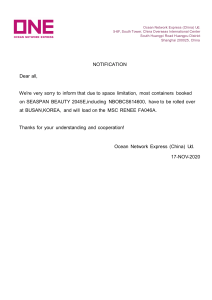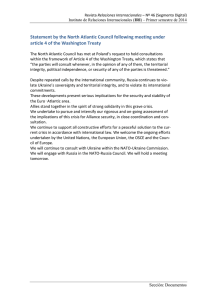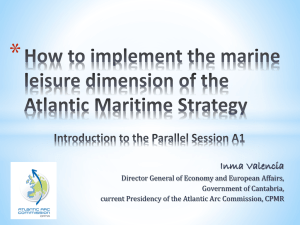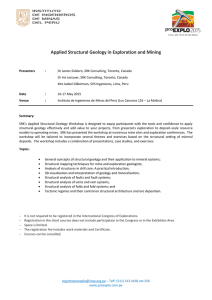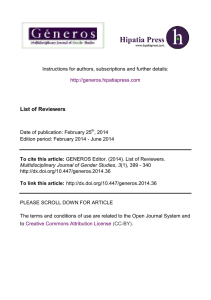Evolution of middle to Late Cretaceous oceans--A 55 m.y. record of Earth's temperature and carbon cycle (2012)pdf
Anuncio
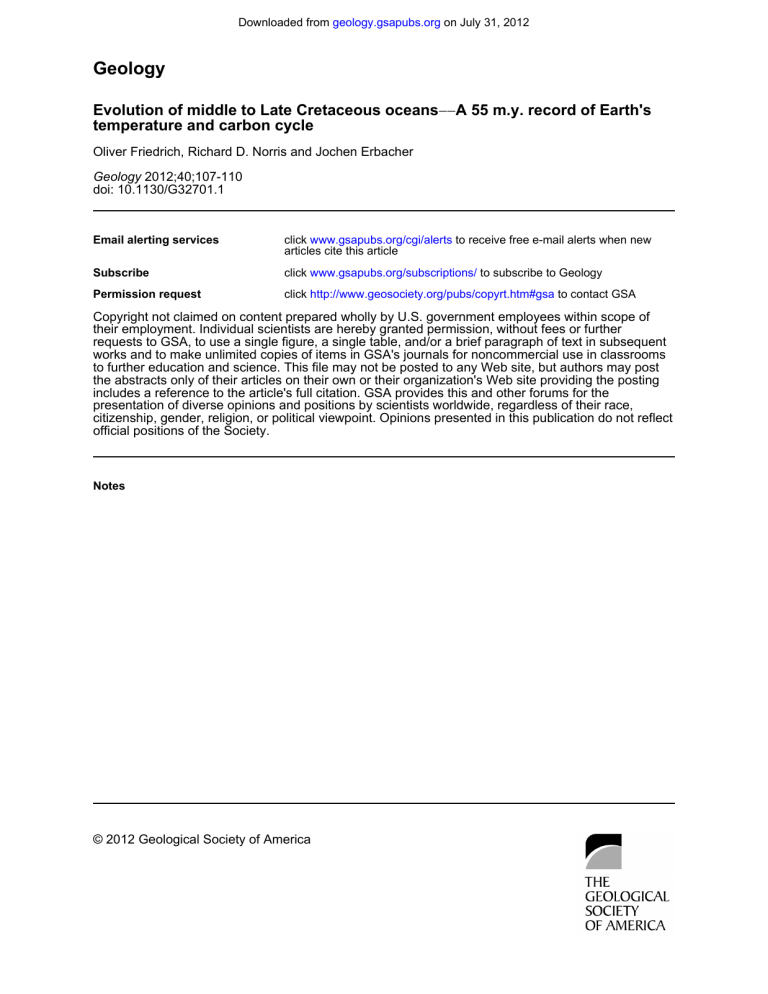
Downloaded from geology.gsapubs.org on July 31, 2012 Geology Evolution of middle to Late Cretaceous oceans−−A 55 m.y. record of Earth's temperature and carbon cycle Oliver Friedrich, Richard D. Norris and Jochen Erbacher Geology 2012;40;107-110 doi: 10.1130/G32701.1 Email alerting services click www.gsapubs.org/cgi/alerts to receive free e-mail alerts when new articles cite this article Subscribe click www.gsapubs.org/subscriptions/ to subscribe to Geology Permission request click http://www.geosociety.org/pubs/copyrt.htm#gsa to contact GSA Copyright not claimed on content prepared wholly by U.S. government employees within scope of their employment. Individual scientists are hereby granted permission, without fees or further requests to GSA, to use a single figure, a single table, and/or a brief paragraph of text in subsequent works and to make unlimited copies of items in GSA's journals for noncommercial use in classrooms to further education and science. This file may not be posted to any Web site, but authors may post the abstracts only of their articles on their own or their organization's Web site providing the posting includes a reference to the article's full citation. GSA provides this and other forums for the presentation of diverse opinions and positions by scientists worldwide, regardless of their race, citizenship, gender, religion, or political viewpoint. Opinions presented in this publication do not reflect official positions of the Society. Notes © 2012 Geological Society of America Downloaded from geology.gsapubs.org on July 31, 2012 Evolution of middle to Late Cretaceous oceans—A 55 m.y. record of Earth’s temperature and carbon cycle Oliver Friedrich1*, Richard D. Norris1, and Jochen Erbacher 2 1 Scripps Institution of Oceanography, University of California−San Diego, 9500 Gilman Drive, La Jolla, California 92093-0244, USA Bundesanstalt für Geowissenschaften und Rohstoffe, Stilleweg 2, 30655 Hannover, Germany 2 ABSTRACT A new 55 m.y. global compilation of benthic foraminifera δ13C and δ18O for the middle to Late Cretaceous shows that there was widespread formation of bottom waters with temperatures >20 °C during the Cretaceous greenhouse world. These bottom waters filled the silled North Atlantic and probably originated as thermocline or intermediate waters in the tropical oceans. Carbon burial during the Cretaceous oceanic anoxic events produced a positive δ13C shift in global carbon reservoirs, but this is not particularly large, especially by comparison with the remarkable Late Paleocene carbon maximum. The interbasin δ13C gradient was unusually large during the Cretaceous hot greenhouse, probably because the North Atlantic sills prevented the free exchange of waters in the deep basin. The hot greenhouse ended when the Equatorial Atlantic Gateway opened sufficiently to flood the deep North Atlantic with relatively cool polar waters formed in the Southern Ocean. INTRODUCTION Recent studies have shown that Earth’s climate and oceans underwent significant changes during the Cretaceous Period. These changes include the increase of global temperatures, peaking in the warmest ever reported temperatures during the early Late Cretaceous hot greenhouse (surface waters >35 °C and deep-ocean water >20 °C; Huber et al., 2002; Norris et al., 2002; Forster et al., 2007; Friedrich et al., 2008). There is also evidence for changing ocean circulation related to gateway opening (Jones et al., 1995; Frank and Arthur, 1999), high pCO2 (Bice and Norris, 2002; Bice et al., 2006), repeated episodes of burial of organic matter during oceanic anoxic events (OAEs; Arthur et al., 1988; Schlanger and Jenkyns, 1976; Wilson and Norris, 2001), and probably short-lived glaciation events (Miller et al., 1999; Bornemann et al., 2008). While the dynamics of short-term events like OAEs are well studied, the broad evolution of Cretaceous climate and oceans is poorly resolved due to low-resolution sampling and large time gaps (Huber et al., 2002; Cramer et al., 2009) or diagenetically altered samples (Clarke and Jenkyns, 1999). We have produced new stable isotope data sets from benthic foraminifera and compiled them with literature data (Fig. 1) to construct a global deep-sea isotope record (see the GSA Data Repository1). METHODS Our new stable isotope data were generated from an ~100-m-thick, Corg-rich, laminated marlstone sequence of Cenomanian to Santonian age containing exceptionally well preserved (glassy) foraminiferal tests (e.g., Norris et al., 2002; Bornemann et al., 2008; Friedrich et al., 2008) from the western equatorial Atlantic at Demerara Rise (Ocean Drilling Program Leg 207; Fig. DR1 and Table DR1 in the Data Repository). We also analyzed samples from Turonian to Campanian sediments from the tropical Pacific Ocean (Deep Sea Drilling Project Sites 305 and 463; Fig. DR1, Tables DR2 and DR3, respectively). Samples were picked for monospecific samples of benthic foraminifera (10–100 individuals) and run on a Fisons Prism III isotope ratio mass spectrometer at the University of California−Santa Cruz (Sites 305, 463, 1259) and on a Finnigan MAT 251 mass spectrometer at the Leibniz-Labor (Kiel, 90N 150 120 60 30W RESULTS The new Cretaceous (115–65 Ma; Fig. 2) benthic oxygen isotope (δ18Ob) compilation is characterized by a total δ18Ob range of ~5.5‰. Before 97 Ma, the data show a pronounced trend that culminates in the lowest δ18Ob values between 97 and 90 Ma. A >2‰ increase in δ18Ob occurred during the next 12 m.y., followed by relatively stable δ18Ob values up to 71 Ma. The last 6 m.y. of the Cretaceous are characterized by short-term oscillations in δ18Ob superimposed by a >1‰ positive δ18Ob excursion around the Campanian-Maastrichtian boundary (Fig. 2; Fig. DR2). The benthic carbon isotope (δ13Cb) compilation shows a total range of ~6‰ (Fig. 2; Fig. DR2). Before 97 Ma, δ13Cb values range between 0‰ and 2‰ and include substantial interocean gradients. Between 97 and 90 Ma, δ13Cb values increase by ~1‰, followed by a long-lasting decrease of >2‰ to 70 Ma. Tropical Atlantic data (Ocean Drilling Program Leg 207) are 2‰–3‰ lower than contemporaneous Pacific Ocean and Southern Ocean data. After 70 Ma, δ13Cb values increase globally by >1‰ (Fig. 2; Fig. DR2). 0 30E 60 90 120 150 180 N 60N 1049-1052 551 390 384 30N 305 1258-1261 0 *Current address: Institut für Geowissenschaften, Goethe-Universität Frankfurt, Altenhöferallee 1, 60438 Frankfurt, Germany. 1 GSA Data Repository item 2012043, materials, data source and age models, references, and Table DR1 (location of sites), Tables DR2–DR4 (new isotope data), and Figures DR1–DR3 (new data, isotope trends, and compilation with Zachos et al., 2008), is available online at www.geosociety.org/pubs/ft2012.htm, or on request from [email protected] or Documents Secretary, GSA, P.O. Box 9140, Boulder, CO 80301, USA. 90 Germany; all other sites). The analytical precision was <0.05‰ and <0.07‰ for δ18O and δ13C, respectively. Paleotemperatures are estimated by applying the equation of Bemis et al. (1998), assuming a δ18Oseawater of −1.0 ‰ (Shackleton and Kennett, 1975) and isotopic equilibrium of foraminifera with seawater. 463 30S 525 60S 511 690 761 750 90S Figure 1. Paleogeographic reconstruction for 95 Ma (after Hay et al., 1999) showing sites used in this study. © 2012 Geological Society of America. For permission to copy, contact Copyright Permissions, GSA, or [email protected]. GEOLOGY, February 2012 Geology, February 2012; v. 40; no. 2; p. 107–110; doi:10.1130/G32701.1; 3 figures; Data Repository item 2012043. 107 Downloaded from geology.gsapubs.org on July 31, 2012 (‰) (‰) Early Maastrichtian cooling and/or glaciation? Paleotemperature ( ) Figure 2. Stable oxygen and carbon isotope compilation of benthic foraminifera for 115–65 Ma. Black—North Atlantic Ocean, gray— southern high latitudes, red—Pacific Ocean, blue—subtropical South Atlantic Ocean, green—Indian Ocean. OAE—oceanic anoxic event; EAG—Equatorial Atlantic Gateway. Data sources are in the GSA Data Repository (see footnote 1). DISCUSSION New Benthic Isotope Compilation for the Cretaceous We interpret δ18Ob to be largely a function of variations in temperatures on the assumption that, with possibly a few exceptions (e.g., Bornemann et al., 2008; Miller et al., 1999), the middle to Late Cretaceous was ice free. There has been a long-standing hypothesis that variations in ocean salinity may also have contributed significantly to the δ18Ob record (e.g., Brass et al., 1982); however, we judge this to be a small effect compared to temperature variations for open-ocean settings (see following discussion). We have separated the Cretaceous isotope compilation into four intervals based upon our interpretation of the data: (1) the increasing temperatures before 97 Ma; (2) the subsequent Cretaceous hot greenhouse interval (paralleled by increasing δ13Cb values); (3) the long-lasting cooling trend and decrease in δ13Cb between 91 and 78 Ma; and (4) the interval after 78 Ma with 108 small interocean δ13Cb and δ18Ob values and a major increase in both δ18Ob and δ13Cb between 70 and 68 Ma (Fig. 2). The increasing warming before 97 Ma (interval 1) and subsequent extremely warm period between 97 and 91 Ma (interval 2) is known from low-resolution stable isotope studies (Clarke and Jenkyns, 1999; Huber et al., 2002) and has been related to increasing amounts of greenhouse gases in the atmosphere (Bice et al., 2006). Stable isotope and Mg/Ca data of planktic foraminifera (Wilson et al., 2002; Norris et al., 2002; Bice et al., 2006; Bornemann et al., 2008) and the TEX86 proxy (Forster et al., 2007) suggest tropical sea-surface temperatures >35 °C for this peak interval of the Cretaceous hot greenhouse, and therefore surface ocean temperatures ~7–8 °C hotter than today. Our benthic foraminifer stable isotope data suggest that intermediate to bottom waters (IBW) in the southern high latitudes and the Pacific Ocean were as warm as 20 °C, whereas the tropical proto–North Atlantic shows even higher tem- peratures (Fig. 2; Friedrich et al., 2008). These high temperatures can be partly explained by polar warmth at the sites of high-latitude deepwater overturning (Huber et al., 2002). The high temperatures in the deep proto–North Atlantic likely reflect the existence of shallow sills that prevented all but warm thermocline or intermediate waters from entering the basin (Poulsen et al., 2001). Formation of warm, saline water within the surrounding epicontinental shelf seas may also have contributed to waters filling the deeper North Atlantic (Friedrich et al., 2008; Berrocoso et al., 2010), a mechanism working on a local scale rather than influencing the whole ocean. The existence of these warm, saline waters from 97 to 91 Ma may have resulted in δw having been more positive, meaning that our paleotemperature estimates (Fig. 2) are probably too low. The massive storage of organic carbon in black shales led to a positive trend in δ13Cb between 97 and 90 Ma. The δ13Cb values of the tropical Atlantic Ocean, however, are extremely GEOLOGY, February 2012 Downloaded from geology.gsapubs.org on July 31, 2012 (‰) (‰) -2 -1 0 1 2 3 4 15 20 25 30 Mi-1 Oi-1 55 60 65 70 75 80 85 90 95 100 105 110 115 PETM Cen. Tu. Co S Campan. Ma. Paleoc. 50 K/T OAE 2 A. Albian 45 Eocene 35 40 -4 Miocene 10 -2 Olig. 5 0 Pl. 0 2 -2 OAE 1b -1 0 1 2 3 4 2 0 -2 -4 Figure 3. Stable oxygen and carbon isotope compilation of benthic foraminifera for past 115 m.y. Cenozoic data after Cramer et al. (2009). Note that Cenomanian to early Turonian benthic δ18O data of Demerara Rise are not included in this compilation due to influence of warm, saline intermediate to bottom waters (IBW). The benthic δ13C data from Demerara Rise are not included due to negative offset (see text). Mi-1—major Miocene glaciation event, Oi-1—major Oligocene glaciation event, PETM—Paleocene-Eocene thermal maximum; K/T— Cretaceous-Tertiary boundary, OAE—oceanic anoxic event, A.—Aptian, Cen.—Cenomanian, Tu.—Turonian, Co—Coniacian, S—Santonian, Campan.—Campanian, Ma.—Maastrichtian, Paleoc.—Paleocene, Olig.—Oligocene, Pl.—Pliocene. negative when compared to other ocean basins (Fig. 2). This phenomenon likely reflects a long residence time of local bottom waters due to relatively shallow sills between the North Atlantic and the Pacific and South Atlantic Oceans. Nonetheless, the most significant carbon cycle perturbation is not associated with OAE formation during the middle Cretaceous, but occurred in the Middle to Late Paleocene, a time of relatively cool climate (Fig. 3). Although the Cretaceous OAEs were major periods of oil formation, they may not involve as large a global episode of carbon burial and subsequent exhumation as in the Paleocene. Interval 3 (91–78 Ma) shows two distinctive parts. Between 91 and 84 Ma, δ18Ob values of all ocean basins (where data are available) are similar. The common trend may result from the initial opening of the Equatorial Atlantic Gateway (EAG) between Africa and South GEOLOGY, February 2012 America. Deepening this gateway would allow South Atlantic intermediate water to invade the proto–North Atlantic, filling the deep Atlantic with cool high-latitude waters. While several studies claim that the EAG was breached in the early Turonian (Tucholke and Vogt, 1979; Summerhayes, 1987; Pletsch et al., 2001), climate models (Handoh et al., 1999), benthic foraminifera (Friedrich and Erbacher, 2006), and sedimentological evidence (van Andel et al., 1977; Jones et al., 1995) suggest that a permanent deep-water connection was not established until the Santonian to Campanian. Our data support a substantial connection between the North and South Atlantic by the late Turonian. Between ca. 84 and 78 Ma, we see a separation of water masses between the Southern Ocean and the cooler temperatures and higher δ13C values of the Pacific, possibly reflecting multiple IBW sources. The last 13 m.y. of the Cretaceous are characterized by small interbasin gradients for both δ18Ob and δ13Cb. This could be related to a full connection between all ocean basins (especially due to the complete opening of the EAG). Nonetheless, the North Atlantic shows more positive δ13Cb values throughout the Maastrichtian than the other oceans, which may reflect local formation of deep water (Frank and Arthur, 1999; Friedrich et al., 2004). The Pacific, in contrast, exhibits the lowest δ13Cb values during this time, possibly reflecting a more distant source region. A pronounced positive δ13Cb excursion between 70 and 68 Ma is obvious in all data sets (Fig. 1), reflecting global carbon burial accompanied by a positive δ18Ob excursion interpreted to reflect a short-term glaciation event (e.g., Barrera and Savin, 1999; Miller et al., 1999) and/or reorganization of IBW sources (e.g., Barrera et al., 1997; Friedrich et al., 2009). 115 MA COMPILATION Comparison of our data with the Cenozoic compilation (0–65.5 Ma; Cramer et al., 2009; for comparison with the compilation of Zachos et al., 2008, see Fig. DR3) shows that the interval between 97 and 91 Ma was by far the warmest greenhouse climate during the past 115 m.y. After this interval of extreme warmth, the deep oceans started to cool, a process continuing to today. Only two greenhouse periods interrupted the cooling, i.e., the Early Eocene (47–55 Ma) and the Early to Middle Miocene (15–20 Ma; Fig. 3), both of which are comparable in their duration with the middle Cretaceous thermal maximum. Intermediate and bottom waters of the Cenozoic warm periods never reached the high temperatures of the Cretaceous hot greenhouse climate. Instead, extreme Cretaceous warmth was probably ended by the tectonic dissection of silled North Atlantic basins and the opening of oceanic connections to the poles that allowed waters cooled in the polar winter to flood the rest of the deep ocean. The reason for the general cooling trend between 91 and 78 Ma is still unresolved. Lowresolution isotope data from the southern high latitudes and the North Atlantic show only a small decrease in temperatures, leading to the suggestion that the entire interval was part of the Cretaceous hot greenhouse (Huber et al., 2002). Based on our compilation, however, we propose that deepening of the EAG and the parallel reorganization of the oceanic circulation with longitudinal water-mass and heat exchange within the Atlantic Ocean favored cooling by the late Turonian. These tectonic effects may have been strengthened by the parallel decrease of greenhouse gases (Bice et al., 2006; Pucéat et al., 2007), decreasing ocean-crust production (Larson, 1991), and diminished formation of warm and saline intermediate water masses. 109 Downloaded from geology.gsapubs.org on July 31, 2012 This explanation is also supported by the general decrease in δ13Cb values that is obvious in all ocean basins. A better connection of the former restricted proto–North Atlantic basin, and therefore an input of oxygenated waters from the south, would allow the oxidization of the organic-rich sediments formed in this basin and mark the end of the proto–North Atlantic as a carbon sink. ACKNOWLEDGMENTS We thank D. Andreasen and N. Andersen for stable isotope measurements and the Ocean Drilling Program for providing samples. We thank P. Wilson, K. Miller, and an anonymous reviewer for useful comments that significantly improved the manuscript. Funding for this study was provided by the German Research Foundation (DFG) (Friedrich, FR 2544/1-1 and FR 2544/2-1; Erbacher, ER 226/1-2) and by the U.S. National Science Foundation−Marine Geology and Geophysics (Norris). REFERENCES CITED Arthur, M.A., Dean, W.E., and Pratt, L.M., 1988, Geochemical and climatic effects of increased marine organic carbon burial at the Cenomanian/ Turonian boundary: Nature, v. 335, p. 714–717, doi:10.1038/335714a0. Barrera, E., and Savin, S.M., 1999, Evolution of late Campanian–Maastrichtian marine climates and oceans, in Barrera, E., and Johnson, C.C., eds., Evolution of the Cretaceous ocean-climate system: Geological Society of America Special Paper 332, p. 245–282, doi:10.1130/0-8137-2332-9 .245. Barrera, E., Savin, S.M., Thomas, E., and Jones, C.E., 1997, Evidence for thermohaline-circulation reversals controlled by sea-level change in the latest Cretaceous: Geology, v. 25, p. 715–718, doi:10.1130/0091-7613(1997)025<0715: EFTCRC>2.3.CO;2. Bemis, B.E., Spero, H.J., Bijma, J., and Lea, D.W., 1998, Reevaluation of the oxygen isotopic composition of planktonic foraminifera: Experimental results and revised paleotemperature equations: Paleoceanography, v. 13, p. 150–160, doi:10.1029/98PA00070. Berrocoso, A.J., MacLeod, K.G., Martin, E., Bourbon, E., Londoño, C.I., and Basak, C., 2010, Nutrient trap for Late Cretaceous organic-rich black shales in the tropical North Atlantic: Geology, v. 38, p. 1111–1114, doi:10.1130/G31195.1. Bice, K.L., and Norris, R.D., 2002, Possible atmospheric CO2 extremes of the middle Cretaceous (late Albian–Turonian): Paleoceanography, v. 17, doi:10.1029/2002PA000778. Bice, K.L., Birgel, D., Meyers, P.A., Dahl, K.A., Hinrichs, K.-U., and Norris, R.D., 2006, A multiple proxy and model study of Cretaceous upper ocean temperatures and atmospheric CO2 concentrations: Paleoceanography, v. 21, doi:10.1029/ 2005PA001203. Bornemann, A., Norris, R.D., Friedrich, O., Beckmann, B., Schouten, S., Sinninghe Damsté, J.S., Vogel, J., Hofmann, P., and Wagner, T., 2008, Isotopic evidence for glaciation during the Cretaceous supergreenhouse: Science, v. 319, p. 189–192, doi:10.1126/science.1148777. Brass, G.W., Southam, J.R., and Peterson, W.H., 1982, Warm saline bottom waters in the ancient ocean: Nature, v. 296, p. 620–623, doi:10.1038/ 296620a0. Clarke, L.J., and Jenkyns, H.C., 1999, New oxygen isotope evidence for long-term Cretaceous 110 climatic change in the Southern Hemisphere: Geology, v. 27, p. 699–702, doi:10.1130/0091-7613 (1999)027<0699:NOIEFL>2.3.CO;2. Cramer, B.S., Toggweiler, J.R., Wright, J.D., Katz, M.E., and Miller, K.G., 2009, Ocean overturning since the Late Cretaceous: Inferences from a new benthic foraminiferal isotope compilation: Paleoceanography, v. 24, doi:10.1029/2008PA001683. Forster, A., Schouten, S., Moriya, K., Wilson, P.A., and Sinninghe Damsté, J.S., 2007, Tropical warming and intermittent cooling during the Cenomanian/ Turonian oceanic anoxic event 2: Sea surface temperature records from the equatorial Atlantic: Paleoceanography, v. 22, doi:10.1029/2006PA001349. Frank, T.D., and Arthur, M.A., 1999, Tectonic forcings of Maastrichtian ocean-climate evolution: Paleoceanography, v. 14, p. 103–117, doi:10.1029/1998PA900017. Friedrich, O., and Erbacher, J., 2006, Benthic foraminiferal assemblages from Demerara Rise (ODP Leg 207, western tropical Atlantic): Possible evidence for a progressive opening of the Equatorial Atlantic Gateway: Cretaceous Research, v. 27, p. 377–397, doi:10.1016/j.cretres.2005.07.006. Friedrich, O., Herrle, J.O., Kößler, P., and Hemleben, C., 2004, Early Maastrichtian stable isotopes: Changing deep water sources in the North Atlantic?: Palaeogeography, Palaeoclimatology, Palaeoecology, v. 211, p. 171–184, doi:10.1016/j. palaeo.2004.05.004. Friedrich, O., Erbacher, J., Moriya, K., Wilson, P.A., and Kuhnert, H., 2008, Warm saline intermediate waters in the Cretaceous tropical Atlantic Ocean: Nature Geoscience, v. 1, p. 453–457, doi:10.1038/ ngeo217. Friedrich, O., Herrle, J.O., Cooper, M.J., Erbacher, J., Wilson, P.A., and Hemleben, C., 2009, The early Maastrichtian carbon cycle perturbation and cooling event: Implications from the South Atlantic Ocean: Paleoceanography, v. 24, PA221, doi:1012/2008PA001654. Handoh, I.C., Bigg, G.R., Jones, E.J.W., and Inoue, M., 1999, An ocean modeling study of the Cenomanian Atlantic: Equatorial paleo-upwelling, organic-rich sediments and the consequences for a connection between the proto-North and South Atlantic: Geophysical Research Letters, v. 26, p. 223–226, doi:10.1029/1998GL900265. Hay, W.W., DeConto, R., Wold, C.N., Wilson, K.M., Voigt, S., Schulz, M., Wold-Rossby, A., Dullo, W.-C., Ronov, A.B., Balukhovsky, A.N., and Söding, E., 1999, Alternative global Cretaceous paleogeography, in Barrera, E., and Johnson, C.C., eds., Evolution of the Cretaceous oceanclimate system: Geological Society of America Special Paper 332, p. 1–47, doi:10.1130/0-81372332-9.1. Huber, B.T., Norris, R.D., and MacLeod, K.G., 2002, Deep-sea paleotemperature record of extreme warmth during the Cretaceous: Geology, v. 30, p. 123–126, doi:10.1130/00917613(2002)030<0123:DSPROE>2.0.CO;2. Jones, E.J.W., Cande, S.C., and Spathopoulos, F., 1995, Evolution of a major oceanographic pathway: The equatorial Atlantic, in Scrutton, R.A., et al., eds., The tectonics, sedimentation and palaeoceanography of the North Atlantic region: Geological Society of London Special Publication 90, p. 199–213, doi:10.1144/GSL.SP.1995 .090.01.12. Larson, R.L., 1991, Latest pulse of Earth: Evidence for a mid-Cretaceous superplume: Geology, v. 19, p. 547–550, doi:10.1130/0091-7613(1991)019 <0547:LPOEEF>2.3.CO;2. Miller, K.G., Barrera, E., Olsson, R.K., Sugarman, P.J., and Savin, S.M., 1999, Does ice drive early Maastrichtian eustasy?: Geology, v. 27, p. 783–786, doi:10.1130/0091-7613(1999)027 <0783:DIDEME>2.3.CO;2. Norris, R.D., Bice, K.L., Magno, E.A., and Wilson, P.A., 2002, Jiggling the tropical thermostat in the Cretaceous hothouse: Geology, v. 30, p. 299– 302, doi:10.1130/0091-7613(2002)030<0299: JTTTIT>2.0.CO;2. Pletsch, T., Erbacher, J., Holbourn, A.E.L., Kuhnt, W., Moullade, M., Oboh-Ikuenobede, F.E., Soding, E., and Wagner, T., 2001, Cretaceous separation of Africa and South America: The view from the West African margin (ODP Leg 159): Journal of South American Earth Sciences, v. 14, p. 147– 174, doi:10.1016/S0895-9811(01)00020-7. Poulsen, J.P., Barron, E.J., Arthur, M.A., and Peterson, W.H., 2001, Response of the mid-Cretaceous global oceanic circulation to tectonic and CO2 forcings: Paleoceanography, v. 16, p. 576–592, doi:10.1029/2000PA000579. Pucéat, E., Lécuyer, C., Donnadieu, Y., Naveau, P., Cappetta, H., Ramstein, G., Huber, B.T., and Kriwet, J., 2007, Fish tooth δ18O revising Late Cretaceous meridional upper ocean water temperature gradients: Geology, v. 35, p. 107–110, doi:10.1130/G23103A.1. Schlanger, S.O., and Jenkyns, H.C., 1976, Cretaceous oceanic anoxic events: Causes and consequences: Geologie en Mijnbouw, v. 55, p. 179–184. Shackleton, N.J., and Kennett, J.P., 1975, Paleotemperature history of the Cenozoic and the initiation of Antarctic glaciation: Oxygen and carbon isotope analysis in DSDP Sites 277, 279, and 280, in Kennett, J.P., et al., Initial reports of the Deep Sea Drilling Project, Volume 29: Washington, D.C., U.S. Government Printing Office, p. 743–755, doi:10.2973/dsdp.proc.29.117.1975. Summerhayes, C.P., 1987, Organic-rich Cretaceous sediments from the North Atlantic, in Summerhayes, C.P., and Shackleton, N.J., eds., North Atlantic palaeoceanography: Geological Society of London Special Publication 26, p. 301–316, doi:10.1144/GSL.SP.1987.026.01.21. Tucholke, B.E., and Vogt, P.R., 1979, Western North Atlantic sedimentary evolution and aspects of tectonic history, in Tucholke, B.E., et al., Initial reports of the Deep Sea Drilling Project, Volume 43: Washington, D.C., U.S. Government Printing Office, p. 791–825, doi:10.2973/dsdp. proc.43.140.1979. van Andel, T.H., Thiede, J., Sclater, J.G., and Hay, W.W., 1977, Depositional history of the South Atlantic Ocean during the last 125 million years: Journal of Geology, v. 85, p. 651–698, doi:10.1086/628357. Wilson, P.A., and Norris, R.D., 2001, Warm tropical ocean surface and global anoxia during the midCretaceous period: Nature, v. 412, p. 425–429, doi:10.1038/35086553. Wilson, P.A., Norris, R.D., and Cooper, M.J., 2002, Testing the Cretaceous greenhouse hypothesis using glassy foraminiferal calcite from the core of the Turonian tropics on Demerara Rise: Geology, v. 30, p. 607–610, doi:10.1130/00917613(2002)030<0607:TTCGHU>2.0.CO;2. Zachos, J.C., Dickens, G.R., and Zeebe, R.E., 2008, An early Cenozoic perspective on greenhouse warming and carbon-cycle dynamics: Nature, v. 451, p. 279–283, doi:10.1038/nature06588. Manuscript received 1 August 2011 Revised manuscript received 7 September 2011 Manuscript accepted 8 September 2011 Printed in USA GEOLOGY, February 2012
